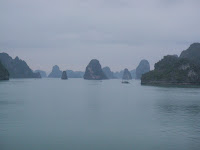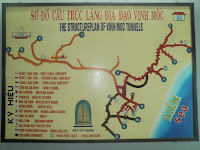
That's what we saw while boarding our flight out of Vietnam. Hmmm. And I thought you just plain weren't allowed to bring them on. I guess if you ask politely...
Anyway, the Philippines...

Right away as soon as we got off the plane we began to fall in love with the country. People are really nice – and not because they want to sell you something. Everyone speaks English to a very high level, which just makes everything easy, and there's a ton of things to do and see, which we discovered as we traveled north to the tiny village of Batad. Home to just 3,000 people, Batad is almost that many years old. The village mainly exists for the terraced rice paddies carved into the mountain side. This is basically a rice farm on a 45 degree angle!

Since there are no roads to get there we had to walk a few hours from the nearest road. Hot and in need of a bath, where better to freshen up than the waterfall (which was another hour walk away)...

We planned to spend the night there, and lucked out when we found a villager who rents out a traditional hut for the night. This is the real thing – over 200 years old. You walk up and duck under the low roof to find a ladder that leads up inside...

And once you're inside, when you look up at the ceiling inside, it had all these animal skulls. Creepy...

We wanted to cover more ground, so we just spent one night, and then walked out early the next morning. We caught a bus to another small village – this one named Sagada. One of the interesting attractions of Sagada is the huge cave

We sort of ended up at the cave by accident and thus unprepared, but we ventured inside anyway. It didn't take us long to realize that without lights we couldn't get too far. That's when I remembered that my camera has a little red-eye reduction light (separate from the flash) and it can be forced to turn on. Not much of a flashlight, but we did get a ways further. That's when Amada's wisdom prevailed and said something along the lines that this tiny light will only be able to get us into trouble, but not out of it. And wouldn't you know it – right about then a tour group was entering – with a nice big lamp that totally lit up the inside. So we asked if we could pay and join their tour and then we were all on our way. At one point it is necessary to get a little wet as the water is about knee level, so we rolled up our pants and removed our shoes and continued on.
There is another cave withing walking distance, and we visited this one also – but for a different reason. This one is known because of its use as a traditional burial site. Bodies were put into hollowed out tree trunks and placed into this cave.

The last body to be placed in this manner was not all that long ago – it was the late 1980's.
And while on the topic of burial ceremonies there are also the “hanging coffins” in Sagada. These are wooden coffins placed onto the vertical face of a mountain cliff.

But I'm telling the story in reverse. Before a body is put into a coffin (hanging or otherwise) the deceased is first placed on a wooden chair, and their body tied in place to hold it from falling or slumping. The wrists and ankles were bound to the chair, straps hold across the waist and chest, and then a wide strap to hold up the head is strapped across the mouth. This chair was then hoisted up – maybe five feet up, and people came to “talk” with the recently departed. This could last from a day, to maybe even a month – depending on how much money the departed's family could afford for hosting the visitors. And paying your respects could be just about anything – you had carte blanche to even tell the dead what a terrible person they were. But hopefully you had nice things to say. The photo we saw of this practice was really creepy looking – the dead looking like a deity being worshiped. And with that strap across the mouth – wow – that looked really creepy!
So if I'm telling things in reverse order, why not discuss how someone might die out in the remote villages of norther Philippines. Well if you were terribly unlucky, you might succumb to headhunters. Of course everyone has heard of this practice before, but I must admit that I didn't know it was from these parts that headhunting originated. And it was our interest in this which took us to the next village called Bontoc.

Anyway, if you were ill fated enough to run into one of these warriors you might lose your head – literally.

Did you see what he was holding in his hands? It probably came from this poor guy

Wow – that's serious. And we're told they did this for sport. We're also told that headhunting has long since stopped, but I don't know. Some of these remote villages without roads or any connection to the modern world still cling pretty firmly to their traditions, and don't have much need for “civilized” laws, etc. We heard from one traveler that in the region just a little further north than we ventured that some of the tribes were preparing to go to war against each other. He said they had all their weapons laid out and ready and were just waiting for the sign. Apparently that's when the red bird sings. Luckily there were no red birds singing while he was around.
So after four days running through a few of these small villages we took a day to head back to Manila, and that's where one of the little travel miracles happened. Discomfort, bad luck, and being ripped off happen often enough, so I really cherish the times when something unexpected and good happens. It was on the first leg of our way back to Manila that we took a jeepney, which is a custom retrofitted jeep with a long back end attached to carry maybe 20 or 30 people. Sort of like a 4x4 bus. Like this...

A fellow backpacker suggested that we should try sitting on the roof for the two hour drive from Bontoc to Banue, and we did just that...

And that gave us the chance to see completely unobstructed views as we traveled the dangerously high, and dangerously twisty single lane road past some of the roughest and most spectacular views to be had anywhere. Like this....

And just a short 12 hours later we were back in Manila where we arranged transport to go south on the main island of Luzon. Our destination – the coastal village of Donsol, which is famous for.....

whale sharks! These truly are gentle giants. Growing as much as 18 meters in length and weighing up to 20 tons, these guys are actually docile. And Donsol had, literally, tons of them. We swam around with them for maybe three hours (and got quite a sun burn in the process).
Here's a video I took during one of our many encounters...
We headed to Manila after this to deal with several things and did manage to see much of this city of 11 million. One thing we did was visit the Chinese cemetery, which was really interesting. They say that when you die you can't take it with you, but these rich Chinese families are sure trying. Rather than burial plots this cemetery is full of mausoleums. Nice ones. Think two story house with running water, flushing toilets, electricity, air con, kitchen, even maids (living ones). These mausoleums were nicer and larger than many the homes in Manila.

And that was about it for the Philippines. We then boarded a plane for Hong Kong, so stay tuned for that. Oh ya - my so called "tough" Olympus camera died. Again. Ugh. Well, lucky thing we're off to Hong Kong next. That's probably the world's best place to pick up electronics for cheap, so I shouldn't be without a camera for long.




























